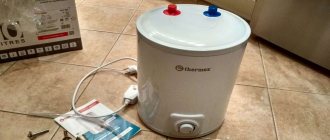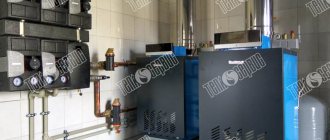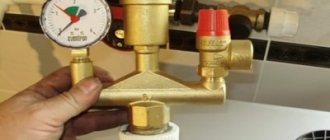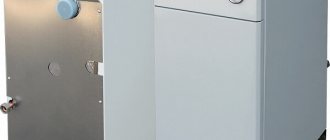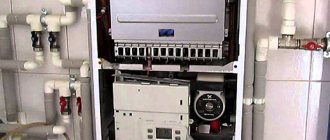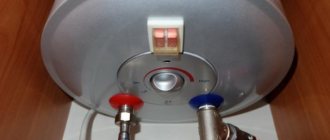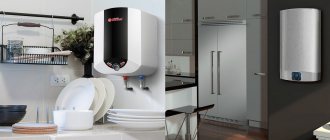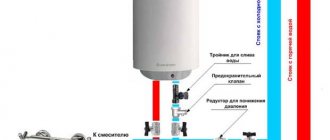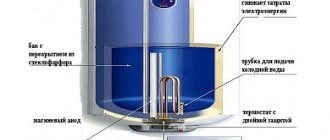Requirements for a storage water heater
Before using a water boiler, you need to familiarize yourself with its main characteristic features:
- When using storage heaters, it takes some time for the water temperature to rise to the optimal temperature.
- Water pressure depends on the pressure in the system. Accordingly, storage and instantaneous water heaters will have different operating conditions.
- Instantaneous water heaters are cheaper than instantaneous water heaters, but more expensive to operate, since they constantly consume electricity while the tap is open.
- The principle of operation of a storage heater is to heat pre-accumulated water to a high temperature and then maintain it at this level. This also consumes electricity, but in much smaller quantities.
Design of a storage water heater Source popechi.ru
- Household electric water heaters do not have special requirements for wiring reliability. When connected to a water supply, particularly high pressure is not required.
- Gas water heaters operate from a regular gas distribution network, but their connection must be carried out by specialists.
- Storage boilers require regular maintenance, especially if there is water in the water supply with a high content of impurities.
- It is not advisable to use water from storage heaters for drinking. For flow-through systems, this restriction does not apply.
- Boilers usually take up quite a lot of space, especially floor-standing models with a large tank.
An example of placing a water heater with hidden communications Source hobot.by
Water heater device
The operating principle of a storage water heater involves intensive transfer of thermal energy to water for initial heating. Then the heater turns off and starts from time to time to maintain the required temperature. If a large amount of hot water is consumed at a time, the heater again switches to intensive heating mode.
In a flow-through boiler, the heating element must heat the water constantly. But since boiling water is not needed at the outlet, the water temperature usually does not exceed 40-60 °C. But even for this you have to spend quite a lot of electricity. Gas heaters are much more economical - they are all flow-type.
Water heater device:
- A reservoir filled with water from a water supply under pressure. In a flow type there is a coil through which water flows.
- Housing with a thick thermal insulation layer.
- Heating element or magnesium anode. If the boiler is gas - chimney and burner. They will ensure heating of water in the container.
- A pipe that supplies cold water and a pipe for discharging hot water from the boiler. It is often equipped with a special valve, which opens when the pressure in the heater increases.
Boiler connection diagram Source otoplenie-gid.ru
- An electronic control unit, which receives data from sensors and displays performance indicators on the display panel, regulates the functioning of the entire boiler. There are keys for manual settings of heating indicators (maximum temperature mode and heating speed).
See also: Catalog of companies that specialize in electrical work, design and installation of water supply and sewerage
Types of storage water heaters
Today, manufacturers offer several types of devices for autonomous hot water supply. Each of them has its own characteristics, depending on the energy carrier used and the method of heating water. The home owner chooses a boiler that is best suited in all respects.
Electric boilers
This is a tank, mainly round or oval in shape, which is enclosed in a heat-insulating layer and covered with a decorative cover. The working tank is made of enameled steel or stainless steel.
You can choose an electric water heater to suit any need Source o-vannoy.ru
At the bottom of the tank there is an electric heating element that heats the water to the temperature set on the thermostat. Usually it is 85 degrees.
While there is no water intake, the heater device assumes maintaining the set temperature indicators in autostart mode and turning off the heating element. That is, the heating element will turn off when the water temperature exceeds 85 degrees, and will start again when the water cools down, for example, to 75 °C.
In general, this is the entire answer to the question of how an electric storage water heater works.
Indirect heating boilers
To understand how an indirect heating water heater works, let’s get acquainted with its structure. The main nuance of their work is that they basically do not heat the water themselves, but take heat from the heating circuit of the house. That is, before going into the heating system, water from the boiler passes through a coil inside the indirect heating boiler and gives off some of the heat to the water in the tank. The water from the heating system and inside the boiler do not mix, so heating is called indirect.
Structure of an indirect heating boiler Source etc-tkr.com.ua
How often and how should you clean your water heater?
The boiler must be cleaned at least once every two years. Manufacturers recommend cleaning once a year. The frequency of cleaning procedures directly depends on the degree of water hardness. If the water is well, hard, or substandard, the boiler will become clogged with scale much faster. In practice, there are cases when the boiler becomes clogged after just two months of use. There are also opposite cases when boilers last 15 years without a single cleaning and remain operational.
There is no need to go to extremes. After purchasing and installing a water heater, about a year or a year and a half later, it is necessary to carry out preventative cleaning. If during the procedure you find that there is not a lot of scale, then cleaning can be done again after two years. If you notice that the boiler takes longer to heat the water and heats a smaller amount of water, and makes a loud hissing noise during operation, this means that urgent cleaning is required. If necessary, along with cleaning the boiler, it is necessary to replace the magnesium anode.
Before cleaning, the device should be disconnected from the electrical network. After this, you need to open the lower compartment of the tank and disconnect the wires. Then you should turn off the cold water, attach a special pipe of a suitable diameter to the drain valve and completely disconnect the pipe that supplies cold water. Draining the water may take more than 30 minutes. After this, you need to remove the heating element. In order to collect scale, you will need a bucket. You should not clean the boiler to perfect condition, as you may damage the parts. Having a flashlight will help when cleaning the tank. After mechanical descaling is completed, the tank should be rinsed and the heating element dried. Then you can begin assembling the water heater. Some people recommend pouring about one liter of vinegar into the tank to better clean the surface. After assembly, be sure to check that there are no leaks. If you are not confident in your abilities, then it is better to entrust the maintenance and cleaning of the unit to professionals.
The best posts
- Purple color in the interior, combination of purple color
- Selection of interior colors for different rooms
- Installation of toilet flushing equipment: main types of flushing, operating mechanism
- How to move the sink?
- Insulation of balconies and loggias - materials, technologies and tips
- Hairpin made of foamiran: master class with video and photo of a rose
- What colors will be fashionable in the new year 2021?
- Niche in the wall: Decorative recess or practical move in the interior of the room
Related article: Types and rules for installing coarse water filters
Video description
For a clear overview of the features of gas boilers, watch this video:
The advantage of boilers is that they are able to supply a large amount of water for domestic hot water needs. And unlike storage electric boilers, they do not require a break to heat the next portion of water.
Flow heaters
Now let’s learn more about how a flow-type electric boiler works. Like gas, it is designed to quickly heat tap water.
The heat source here is electric heating elements, which can be located both inside the water pipe (wet) and outside (dry). They will turn on when a hot water tap is opened, for which an additional sensor is installed in the system.
Advantages of such devices:
- heated water is supplied immediately and for an unlimited time;
- The operation of such water heaters is easy to automate.
Flaws:
- high energy consumption;
- It is difficult to immediately adjust the heating level, which depends on the pressure in the water supply and the initial temperature of the water in it.
Instantaneous water heaters are smaller in size Source homeli.ru
Indirect heating boiler for heating and hot water supply.
The degree of comfort of our lives is firmly connected with such an integral element of civilization as the constant availability of hot water - to wash dishes, do laundry, and wash ourselves. In urban conditions, hot water is more or less present in taps, but in the vast expanses of rural areas there are problems with hot water supply - it is used only for heating houses, circulating in heating systems with single-circuit boilers. The option of providing households with hot water using electric heating boilers is not very attractive - electricity is not cheap, gas boilers or, more commonly, geysers have impressive dimensions and are not able to maintain a constant water temperature. The best option is an indirect heating boiler.
Why do you need an indirect heating boiler?
An indirect heating boiler is purchased together with a single-circuit boiler - together this equipment takes up more space and costs more than a double-circuit boiler. However, their important advantage over a double-circuit boiler is the ability to provide households with a significant amount of hot water almost without interruption, while its temperature will remain unchanged.
Any water heating system based on heating running water has two negative factors - its performance is sufficient only for one or two points of water consumption, and the water temperature is not constant. For example, household members will not be able to simultaneously wash the dishes and, say, take a shower without experiencing a lack of water and a sharp drop in its temperature, which is very unpleasant. It is necessary to develop some kind of internal schedule for the consumption of hot water - if someone intends to take a shower, then he has to inform the other residents of the house about this and ask them not to open the hot water tap and not cause unexpected discomfort to the bather.
In families with a household of 2 or more people, flow-through water heating systems will be ineffective; a more optimal solution is an indirect heating boiler.
When using an indirect heating boiler, the number of simultaneously used points for using hot water is limited only by the capacity of the boiler - the hot water in it is already collected and has the same temperature throughout the entire volume, i.e. you do not have to wait until the water circulation when opening the tap delivers hot water at the required temperature .
Design and principle of operation of an indirect heating boiler
Externally, an indirect heating boiler resembles a metal barrel for collecting water and has a cylindrical shape; it can hold both tens and hundreds of liters of water - the exact volume depends on the specific model. There are boilers of both vertical and horizontal installation - the first type is attached to the wall at a certain height from the floor level and is preferable if the boiler room is small in area. The body of the storage tank is made of enamel-painted steel, plastic and stainless steel - the latter two materials provide a significantly longer service life because they are not subject to corrosion.
1 – cold water inlet (DHW); 2 – tubular heat exchanger; 3 – coolant outlet; 4 – coolant inlet; 5 – hot water output (DHW)
A serpentine heat exchanger pipe made of steel or brass, installed inside an indirectly heated boiler tank, often has a complex shape, which allows the coolant circulating in it to heat the water better and faster. The coils of the heat exchanger can be located closer to the bottom of the boiler tank, where a colder layer of water accumulates, or they can be evenly distributed throughout the entire volume of the tank - according to manufacturers, this arrangement makes it possible to better heat the water and achieve a uniform temperature. There are models of boilers with two tubular heat exchangers, the first of which is designed for circulating coolant from the heating system, the second for coolant from other sources, for example, a solar collector or a heat pump.
In addition to boilers with built-in coils, models without heat exchange tubes are produced - such indirect heating boilers consist of two containers installed one inside the other, the inner one is made of stainless steel, and the coolant circulates between the walls of the outer and inner containers.
1 – cold water inlet (DHW); 2 – coolant outlet; 3 – stainless steel tank; 4 – coolant inlet; 5 – hot water output (DHW)
Inside the boiler, in a tank filled with water, there is a magnesium anode. It is designed to protect the metal container from galvanic corrosion - its electrical potential is lower than that of the metals in the boiler design, so corrosion will affect and destroy the magnesium anode. Requires periodic replacement due to wear and tear - corrosion “eats” it.
Most indirect heating boilers are equipped with an electric heating element, which is used in the warm season when the heating boiler is turned off.
Indirect heating boilers operate according to a fairly simple scheme - cold water enters the boiler tank through the inlet, and the coolant heated by the heating boiler circulates through the heat exchanger coil or between the walls of the double casing, which in turn heats the water in the boiler and maintains its constant temperature. Each indirect heating boiler has inlet and outlet pipes that connect it to the heating boiler, and the heated water flows to the points of its consumption through a special outlet pipe. To reduce heat loss upon contact with the internal atmosphere of the boiler room and eliminate the threat of damage to the boiler due to constant changes in internal and external temperatures, the outside of its container is covered with heat-insulating material made of polyurethane foam, polystyrene foam or mineral wool. The outer casing of an indirect heating boiler has the shape of a cylinder or an oval rectangle.
If water consumption is low, i.e. not higher than 1.3 l/min, installing an indirect heating boiler and a single-circuit boiler is not profitable; it is easier and cheaper to install a double-circuit boiler. It is not beneficial to use such a boiler when heating the coolant with an electric heating boiler or when generating electricity with a diesel generator. In the case when hot water is needed to fill the bath and the heating boiler runs on solid fuel or natural gas, there is no way to do without an indirect heating boiler!
Indirect heating boiler - pros and cons
Positive characteristics:
- does not increase the load on the power grid during the cold season, since it does not use electricity to heat water during this season;
- high productivity, provided that the heat exchanger is equipped with a sufficient diameter and sufficient power of the single-circuit boiler;
- lack of direct contact of the coolant with the heated water, i.e. the inner surface of the coil in an indirect heating boiler comes into contact only with prepared water containing a small amount of salts;
- providing consumers with hot water without first draining it at the point of consumption, achieved by recirculation, inaccessible to other water heating devices without their increased wear
- It is permissible to connect various sources of thermal energy, as well as a seasonal transition from one source of coolant to another.
Negative characteristics
- high cost of a set of equipment (indirect heating boiler + single-circuit boiler) compared to an electric boiler or double-circuit boiler;
- It takes several hours to heat cold water in containers with a volume of 100 liters or more; during the period of heating the water, the heating intensity of residential premises decreases;
- The boiler capacity, especially a large one, takes up a lot of space, which creates difficulties when placing it in the boiler room and requires careful planning.
Let's compare an indirect heating boiler and other types of water heaters:
Gas water heater - its installation requires a design, construction of a chimney and preliminary approval from government agencies. A gas water heater maintenance contract is required. The main disadvantage of this type of water heater is its inability to maintain a stable water temperature.
A gas heater, storage , is similar in most characteristics to an indirect heating boiler, but requires the same preliminary measures as the installation of a gas water heater.
Flow-through electric heater - fast heating of water, but low performance due to lower power than an indirect heating boiler.
A storage electric heater - as in the case of a flow-through electric heater, has less power, which is why it is not able to provide heating of a new portion of water in a short time. A serious disadvantage of any electric heaters is their high energy consumption.
Double-circuit boiler - the performance of this water heater is low, and the temperature of the heated water is not constant. The main disadvantage in solving the problem of hot water supply using double-circuit boilers is the overgrowing of the coil in which the water circulates with lime deposits (scale). As a result, the double-circuit boiler loses power, because scale interferes with heat transfer, the cross-section of the coil tube decreases, which is why water flows in a weak stream when the tap is opened - it is extremely difficult to completely remove scale inside the coil.
How to choose an indirect heating boiler
The choice begins with selecting the optimal volume of boiler capacity. The average consumption of hot water per person per day is as follows: for washing - 6–17 liters; for washing dishes - 20–25 l; for shower - 60–90 l; for taking a bath - 160–180 liters. Based on these data on water consumption, the approximate needs of households are calculated, rounded up, and the required boiler capacity is determined. Keep in mind that an indirect heating boiler with a capacity of 20 liters will heat the water to the optimal temperature in 40 minutes, and for a 200 liter boiler this will take over 6 hours.
Having decided on the boiler capacity and starting to inspect the models offered by stores, pay attention to the materials from which the coil tube, the internal water tank and the thermal insulation between it and the outer casing are made.
Models in the lower price range are equipped with a steel coil welded to the boiler tank; more expensive models have a brass coil, in some models with fins, secured with a flange connection. A removable brass coil is more efficient at heating water and is easy to remove and descale, which is not possible with a welded steel coil.
In inexpensive indirectly heated boilers, the water container is protected from corrosion by a layer of enamel or glass-ceramics, but such a coating will not last long - temperature changes will cause the formation of microcracks in which corrosion processes will begin. Therefore, the best choice would be boilers with stainless steel tanks. Please note: if the boiler tank is made of stainless steel, then the warranty will be more than one year, but if not, up to one year.
Make sure that the thermal insulation between the boiler bodies is made of polyurethane - in cheap models the thermal insulation is built on quickly wearing foam rubber.
Each indirect heating boiler is equipped with cathodic protection , which takes on the effects of galvanic corrosion. There are two ways to protect against such corrosion: a magnesium anode that is replaced every six months or a year; cathodic protection that has an external power supply - it does not need to be changed, but must be connected to the power supply.
An important selection criterion will be the capabilities of a single-circuit boiler to which an indirect heating boiler will be connected - if the boiler’s passport states the coolant flow rate passing through the heat exchanger coil corresponding to 45–50% of the flow rate of the heating boiler installed in your home, then the performance of the heating system at home will significantly decrease . In addition, the DHW heating period will increase.
Check the presence of a thermostat and a safety valve, usually included with the boiler - they are necessary when operating the device.
Indirect heating boilers differ in the installation method: with a volume of up to 200 liters they can be wall-mounted and floor-mounted, with a larger volume - only floor-mounted.
Select an indirect heating boiler > > >
Connecting an indirect heating boiler
It is carried out in a circuit parallel to the heating circuit, into which an independent circulation pump is built - thanks to this, the independence of the hot water supply from the heating system is achieved. In addition, such a connection will allow, if necessary, to completely turn off the heating circuit and direct the coolant only to the boiler.
Installing an indirect heating boiler in a gravity heating system is permissible; it must be introduced into the heating circuit sequentially through the bypass, after the boiler and before the heating devices.
The diagram and procedure for installing the boiler are given in its passport. If you purchased a wall-mounted appliance, you need to raise it to such a height that the bottom is higher than the top of the heating boiler - with this placement, the water in it will heat up faster.
How to remove scale from an indirect heating boiler
According to the instructions supplied with the boiler by the manufacturer, its preventive maintenance is performed every six months to a year; it is better to carry it out twice a year - before the start and at the end of the heating season.
Rules for using a water heater
Before using the boiler, you need to consider the following rules:
- Initially, the device needs to be installed. Proper installation will determine the service life of the device. When installing, you must comply with the manufacturer's requirements.
- Before turning on the heater, you must close the hot water riser. Then the boiler output is connected to it and the system is started. To disconnect, you need to perform the steps in the reverse order.
- When the homeowner leaves for an extended period of time, the heater is disconnected from the power supply.
- Maintenance of the device is required annually.
- The higher the water temperature is set, the more it can be diluted and the slower it will be consumed.
- When there are a large number of consumers in the house, the maximum temperature is set.
Basic rules for using a water heater
Diagram of an electric water heater.
- The device must be installed before use. The service life of the unit largely depends on correct installation. During installation, follow the instructions supplied with the device. If grounding is required, it must be done. In order for the device to work for a long time, it is not recommended to turn it off and on frequently. If hot water is needed every day, then you should not disconnect the device from the network. With frequent switching on and off, the automation can quickly fail.
- Before turning on the boiler, you should close the hot water riser through which it is supplied to the apartment. After this, you can open two taps on the water heater and turn on the power. In order to turn it off, you need to do everything the other way around. If there is no hot water supply to the apartment, then there is no need to close anything. When bathing unnecessarily, do not turn on the hot water frequently.
- If you are leaving for a long time, the boiler must be disconnected from the network. After a year of using the device, preventive maintenance should be carried out. The higher the water temperature is set, the more it needs to be diluted. If there is only one person living in the apartment, you can immediately set the required temperature so that there is no need to dilute the water later. This will save money. If a large number of people live, then you should set the maximum temperature so that there is enough water for everyone.
Article on the topic: Curtains for the children's room - making the right choice
Boiler market overview
Today, there are many Russian and foreign manufacturers on the domestic water heater market, although the latter are predominantly dominant: MTS, Lorenzi Vasco and others.
Many manufacturers are opening full-cycle production in Russia, producing basic components. This allows us to reduce the price on the domestic market and increase the availability of products for a wide range of consumers. One of these developers is considered to be the Italian corporation Ariston, whose heaters have actually already become a domestic brand.
It has been successfully operating in the Russian market for a long period of time, opening its factories and providing Russians with high-quality heaters. The range of models includes various types of water heating equipment.
Ariston is one of the most recognizable brands of water heaters Source goods.ru
